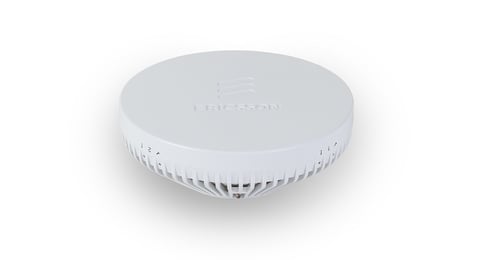Ericsson announced three new small cell solutions for indoor and outdoor deployments, including a multioperator Dot solution that allows multiple operators to share a system with one carrier managing it while others provide RF signals, similar to an active Distributed Antenna System (DAS).
The three solutions are the Multi-Operator Dot, which combines the multioperator benefits of an active DAS solution with the coverage and capacity of the Radio Dot System; the Multi-Dot Enclosure, which is useful for multioperator deployments; and the Strand-Mount Unit for outdoor micro radios.

Ericsson's Radio Dots are small mobile broadband antennas that weigh around 300 grams and are designed to boost mobile coverage. The company launched the small cell product in the fourth quarter of 2014 and previously has said it’s a cost effective means of quickly boosting capacity and network performance.
In a press release, the company said that the new scalable small cell solutions are designed to help expand the small cell market and meet the growing demand for better mobile coverage and capacity while preparing networks for 5G and IoT applications.
“With the Multi-Operator Dot and the Multi-Dot Enclosure, our customers can enhance the inbuilding user experience with excellent connectivity for both smartphones and IoT devices,” said Nishant Batra, head of Product Area Network Infrastructure at Ericsson. “The Strand-Mount Unit for outdoor micro radios, meanwhile, facilitates the dense deployments that will be required for 5G—enabling operators to deploy small cells in areas where they may not have been able to do so previously.”
The most significant element of the announcement is the multioperator version of the Radio Dot, according to Ed Gubbins, senior analyst on the Global Telecom Technology & Software team at GlobalData.
One of the bigger hurdles to penetrating enterprises (which is what the Radio Dot was designed for) has been that enterprises often have multioperator needs—because enterprise inhabitants typically bring their own personal devices to work and have their own operators. The creation of a multioperator Dot is overdue and gives Ericsson a leg up over rivals like SpiderCloud (now Corning), which have single-operator solutions, Gubbins told FierceWirelessTech.
That said, there will still be challenges in penetrating enterprises, even with multioperator solutions. “Getting operators and enterprises to agree on using the same vendor and the same solution on a case-by-case basis isn’t necessarily quick, easy or easily scalable,” he said.
The technologies Ericsson is using to help enable multioperator functionality (MORAN & MOCN) have been around for quite a while, as has the Radio Dot itself. “So the fact that it’s taken years to see a multioperator Radio Dot, despite how long one has been technologically possible to develop, gives some indication that this isn’t perceived as a silver bullet by any means,” he said.
However, the fact that Ericsson is presenting more than one model for multioperator deployment is a good thing; operator and enterprise sentiments will vary, so having some flexibility in this area should help, he added.
Ericsson said its new small cell solutions meet the new market requirements and will be on display at the inaugural Mobile World Congress Americas from September 12 to 14, 2017, and commercially available in 2018.

